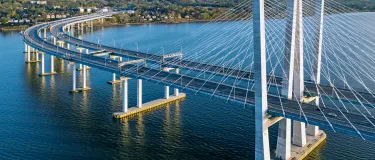Building More with Less: Optimize the Use of Blended Cements to Reduce the Footprint of Construction
The U.S. is about to embark on development at an unprecedented scale with $1.2 trillion in federal spending on infrastructure projects, while also adding a projected 121 billion square feet of buildings by 2050 according to the MIT Concrete Sustainability Hub. While this rapid development will offer significant business and growth opportunities throughout the construction sector, it will prove extremely challenging to our natural environment through increased carbon emissions, depletion of natural resources, and an increase of waste.
As we build the roads, bridges and buildings of tomorrow, an industrywide reliance on low-carbon and circular concrete solutions will be critical to meeting the challenges of sustainable development. One proven strategy to accomplish this is using supplementary cementitious materials (SCMs) and blended cements, yet these readily available products are not being embraced to their full potential.
Advancing Low-Carbon Building Solutions
Concrete, as the most used construction material, offers significant lifespan and durability advantages for meeting the goals of sustainable development. The challenge is that this essential building material also has a significant environmental impact due to the energy intensiveness and generation of CO2 emissions from making ordinary Portland cement (OPC). Given that this is responsible for 90 to 95 percent of the carbon intensity of concrete, reducing the amount of OPC by using alternative cementitious materials is critical to decarbonizing the built environment and mitigating climate change.
Holcim is accelerating the transition to low-carbon building and driving circular construction to reduce, reuse, and recycle materials wherever possible. On our journey to becoming a net-zero company by 2050, we are pursuing ambitious 2030 climate goals of reducing scope 1 and 2 emissions per ton of cementitious materials by 25% (from a 2018 base year). We are also at the forefront of helping the industry “build more with less” by offering our customers a full range of low-carbon cement solutions.
Leading the Transition to Portland Limestone Cement (PLC)
A seamless substitution for OPC with equivalent performance, Holcim’s OneCem® PLC reduces CO2 emissions by five to ten percent per ton of cement. In response to growing demands to reduce the carbon intensity of concrete, we will have fully transitioned 12 of our 13 cement plants—and more than 90% of customers—to OneCem PLC by year-end 2023, making it our standard product wherever we can. In 2022 alone, we supplied the market with more than 10 million tons of this low-carbon blended cement, allowing our customers to significantly reduce the carbon footprint of their building projects.
To provide project teams with detailed data for their assessments on the global warming potential and other environmental impacts of the materials they are using, Holcim publishes third-party validated Environmental Product Declarations (EPDs) for cement products made at all its US manufacturing plants—from Type I/II cements to “green” blended cements, such as OneCem.
Setting the Standard for Green Construction with ECOPlanet Cements
In addition to OneCem PLC, other blended cements and SCMs can be incorporated into concrete mixes to further reduce clinker and CO2 intensity. Holcim is prepared to help customers meet this need with our broad range of ECOPlanet cements. This portfolio of green products offers a minimum 30 percent lower carbon footprint compared to standard cements, along with circular benefits, while providing more durable, high-performance concrete. ECOPlanet green cements also contribute to world-class environmental certifications, such as LEED®, BREEAM® and HQE®, for all types of building projects.
NewCem® Slag Cement. In properly proportioned mixes with OneCem PLC, this finely ground, granulated blast furnace slag (a byproduct of steel manufacturing) significantly increases 28-day strengths and enhances the placeability and finishing characteristics of low-slump concrete. It also increases concrete durability by improving resistance to sulfate attack, mitigating alkali-silica reactions (ASR), reducing permeability, and controlling heat of hydration in mass concrete.
MaxCem® Blended Cement. An optimal combination of OneCem PLC and slag cement, this high-quality blend improves long-term (28 days and beyond) strength gain, workability and finishing properties of concrete. The product also decreases permeability and improves resistance to ASR, making it an ideal solution for a wide variety of reinforced concrete applications. Produced to ensure optimum performance and uniformity, MaxCem meets the requirements of ASTM C989 and AASHTO M 302.
Tercem 3000® Blended Hydraulic Cement. Ideal for projects requiring an ultra-low carbon footprint, this high-performance ternary blend of OneCem PLC, slag cement and silica fume (a byproduct of silicon manufacturing) achieves exceptional 28-day strengths and dramatically densifies concrete—minimizing its permeability and resistance to ASR and sulfate attacks. It shows good freeze-thaw and deicer salt scaling resistance when tested in accordance with ASTM C-666 and ASTM C 672.
FortiCem® Blended Cement. Designed for both general and special use applications, FortiCem is a blended hydraulic cement that combines pozzolans with OPC.
Fly Ash. In properly proportioned mixes, this commonly used pozzolan (a coal combustion byproduct from power plants) results in a denser, more durable concrete. Suitable for a variety of construction applications, fly ash can improve workability, reduce shrinkage and heat of hydration, decrease permeability, improve resistance to sulfate attack, and increase compressive and flexural strengths.
The Future of Low-Carbon Cements
Meeting the enormous challenges of sustainable development can only be achieved through the commitment of all stakeholders across the value chain. The time for action is now. While a broad array of SCMs and blended cements is currently available, the demand for these materials is happening much too slowly to meet net-zero targets. By optimizing the use of these low-carbon cements, project teams will make a significant contribution to reducing the carbon footprint of our growing built environment while supporting a circular economy through the reuse of industrial waste byproducts.
As a global leader in building solutions, Holcim has made enormous strides in driving a more sustainable future, yet our journey has only just begun. We remain steadfast in our commitment to expanding offerings that provide ultra-low CO2 alternatives, and over the last 12 months we have evaluated more than 100 different materials. We are also continuously exploring new ways—including cement products that incorporate construction and demolition waste or the beneficiation of fly ash and bottom ash for use in concrete mixes—to further decarbonize the built environment.







